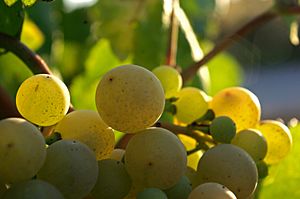Cava (Spanish wine) facts for kids
Cava is a type of sparkling wine from Spain. It has a special status called Denominación de Origen (DO), which means it comes from a specific area. Cava can be white (called blanco) or pink (called rosado).
The most common grapes used to make Cava are Macabeo, Parellada, and Xarel·lo. Sometimes, Chardonnay and Malvasia grapes are also used. For pink Cava, red grapes like Garnacha tinta, Monastrell, Trepat, and Pinot Noir are allowed.
Cava must be made using a special process called the "traditional method." If a sparkling wine from Spain is made differently, it cannot be called Cava. Most Cava (about 95%) comes from the Penedès area in Catalonia, Spain. The town of Sant Sadurní d'Anoia is especially famous for Cava production. Big producers like Codorníu and Freixenet are located there. Cava is also made in other parts of Spain, including areas in Aragon, Extremadura, La Rioja, Navarra, and Valencia.
You might hear people call Cava "Spanish champagne," but this is not allowed by European Union law. This is because Champagne is a special sparkling wine from a specific region in France, and it has a "Protected Geographical Status." This means only sparkling wine from that region can be called Champagne. Cava is officially known as a "quality sparkling wine produced in a designated region."
What Does 'Cava' Mean?
The word cava in Spanish means "cave" or "cellar". In the past, winemakers used caves to store and age their Cava. This helped keep the wine cool and stable.
Spanish winemakers officially started using the name Cava in 1970. They chose this name to clearly show that their sparkling wine was different from French Champagne.
The Story of Cava
Sparkling wine was first made in Catalonia, Spain, as early as 1851. The story of Cava really began with Josep Raventós. In the 1860s, he traveled around Europe to promote still wines from his family's company, Codorníu Winery.
During his travels, he visited the Champagne wine region in France. He became very interested in making a Spanish sparkling wine using the same special "traditional method." In 1872, he made his first sparkling wine. This happened after a plant disease called phylloxera destroyed many vineyards in Penedès. Farmers then replanted their vineyards with white grapevines, which were perfect for making sparkling wine.
Cava producers also helped create an important invention for making sparkling wine. They developed the gyropallet. This is a large machine that helps move the bottles so that the leftover yeast settles in the neck. Before this, workers had to turn each bottle by hand!
How Cava is Made
Spanish law says that Cava can be made in Catalonia and other specific villages across Spain. These include areas in Aragon, Castile and León, Extremadura, La Rioja, Basque Country, Navarre, and Valencia.
To make pink (rosé) Cava, winemakers cannot just mix red and white wines. Instead, they must use a method called Saignée, where the grape skins give the wine its color. Grapes like Garnacha, Pinot Noir, Trepat, or Monastrell are used for this.
Besides Macabeo, Parellada, and Xarel·lo, Cava can also include Chardonnay, Pinot Noir, and Subirat grapes. The first Cava made with Chardonnay grapes was produced in 1981.
Like other quality sparkling wines, Cava comes in different levels of sweetness. These range from very dry, called "brut nature," to "brut," "brut reserve," "seco," "semiseco," and finally, "dulce," which is the sweetest.
See also
 In Spanish: Cava para niños
In Spanish: Cava para niños




